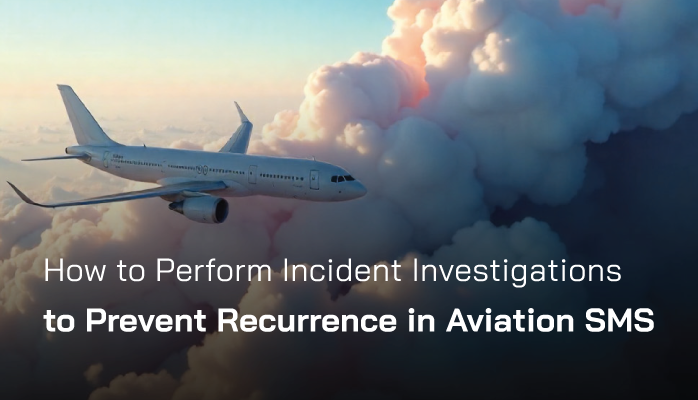How to Investigate Safety Issues

Aviation is one of the safest modes of transportation, thanks to rigorous safety protocols and continuous learning from incidents. For aviation safety managers, incident investigations are a cornerstone of maintaining and enhancing safety. These investigations aim to uncover the root causes of incidents to prevent future occurrences, not to assign blame.
As outlined in ICAO Annex 13, the sole objective is prevention, ensuring lessons learned contribute to safer skies.
This comprehensive guide provides a step-by-step approach to conducting effective incident investigations. It covers
- initial response,
- evidence preservation,
- data collection,
- analysis,
- safety recommendations, and
- reporting.
Best practices, such as systematic root cause analysis and the use of modern technology, are integrated to ensure investigations are thorough and unbiased. A hypothetical case study illustrates the process, offering practical insights for safety managers worldwide. By following these principles, you can enhance safety and contribute to a global culture of continuous improvement.
Section 1: Initial Response and Notification
The moments following an aviation incident are pivotal for ensuring safety and laying the groundwork for an effective investigation. The immediate focus is on protecting lives, securing the scene, and notifying relevant authorities to initiate the process.
Key Actions
- Ensure Safety: Address immediate hazards, such as fuel leaks, unstable wreckage, or environmental risks, and provide medical assistance to affected personnel.
- Notify Authorities: Promptly inform national aviation authorities, aircraft manufacturers, and, for international incidents, organizations like ICAO. Timely notification ensures compliance with regulations and facilitates coordination.
- Establish Communication: Set up a clear chain of command to manage information flow, avoiding confusion or misinformation.
Global Considerations
Regulatory requirements vary by region. In the United States, the FAA and NTSB must be notified per FAA Order 8020.11D. In Europe, the EASA and national authorities play similar roles. Safety managers must be familiar with local protocols to ensure swift and accurate reporting, especially in cross-border incidents involving multiple jurisdictions.
Best Practices
- Act Swiftly: Delays in notification can compromise evidence or delay critical interventions.
- Document Initial Observations: Record initial conditions, such as weather or crew status, to provide context for later analysis.
- Train Staff: Ensure all personnel understand reporting protocols to avoid procedural errors.
Section 2: Securing the Scene and Preserving Evidence
Once immediate safety is assured, the focus shifts to securing the incident scene and preserving evidence. This step is critical to maintaining the investigation’s integrity and ensuring reliable findings.
Safety Precautions
Incident sites pose significant risks, including sharp debris, chemical hazards, or biohazards. According to FAA guidelines, investigators must wear personal protective equipment (PPE), such as helmets, gloves, and fire-resistant clothing. Only trained personnel should access the site to minimize risks and preserve evidence.
Securing the Scene
- Cordon Off the Area: Coordinate with local law enforcement to restrict access, preventing tampering or contamination.
- Preserve Perishable Evidence: Document transient evidence, such as tire marks, fluid spills, or instrument readings, which can degrade rapidly due to weather or human activity.
- Use Comprehensive Photography: Capture the scene from multiple angles, including aerial views, to provide a complete picture.
Preserving Evidence
Physical evidence, such as wreckage, flight data recorders (FDR), or cockpit voice recorders (CVR), must be handled with care to avoid damage or alteration. Witness statements should be collected promptly to capture accurate, untainted recollections. Digital evidence, like maintenance logs or ATC communications, should be backed up securely.
Best Practices
- Leverage Technology: Drones can capture high-resolution aerial footage, offering a detailed view of large or hazardous sites (SKYbrary).
- Chain of Custody: Maintain strict documentation for all evidence to ensure admissibility and reliability.
- Engage Experts: Involve specialists, such as metallurgists or data analysts, to handle complex evidence like damaged components or FDR data.
Section 3: Data Collection

Data collection forms the foundation of an incident investigation, providing the raw material for analysis. A systematic approach ensures all relevant information is gathered without oversight.
Types of Data
- Flight Data: FDR and CVR provide insights into aircraft performance, crew actions, and system status.
- Maintenance Records: Logs of inspections, repairs, or modifications can reveal underlying issues.
- Crew and Witness Interviews: Statements from pilots, cabin crew, ground staff, and bystanders offer firsthand perspectives.
- Weather Data: Conditions like turbulence, icing, or low visibility may have contributed to the incident.
- ATC Communications: Recordings and transcripts provide context for operational decisions.
- Operational Procedures: Reviewing standard operating procedures (SOPs) identifies deviations or gaps.
- Human Factors: Fatigue, training, or communication issues can be critical contributors.
Related Human Factors Articles
- Let’s Talk Human Factors - Origin of Dirty Dozen
- Let’s Talk Human Factors - Lack of Communication
- Let’s Talk Human Factors: Distraction Is #4 of the Dirty Dozen
Global Considerations
Data access may vary by region due to privacy laws or jurisdictional constraints. For example, GDPR in Europe imposes strict rules on handling personal data, such as crew interviews. Safety managers must navigate these regulations while ensuring comprehensive data collection.
Best Practices
- Use Checklists: Standardized checklists, as suggested by ICAO manuals, ensure no data source is overlooked.
- Conduct Structured Interviews: Use open-ended questions to elicit detailed responses without leading witnesses.
- Cross-Verify Data: Compare multiple sources, such as FDR data and crew statements, to ensure consistency.
Section 4: Analysis of Evidence
The analysis phase is where investigators synthesize data to identify immediate and root causes. A rigorous, unbiased approach is essential to avoid premature conclusions or oversights.
Root Cause Analysis Techniques
Several systematic methods help uncover causes:
- 5 Whys: Repeatedly ask “why” to trace the issue to its origin. For example, “Why did the landing gear fail? Because a bolt sheared. Why did it shear? Due to corrosion,” and so on.
- Fishbone Diagram: Categorizes causes into human factors, equipment, procedures, environment, and organization, offering a visual framework.
- Bowtie Analysis: Maps hazards, preventive controls, and mitigation measures, ideal for complex incidents with multiple contributing factors.
- Fault Tree Analysis: Quantitatively assesses the probability of failure, useful for technical issues.
Key Considerations
- Distinguish Causes: Immediate causes (e.g., a failed component) differ from root causes (e.g., inadequate quality control).
- Avoid Bias: Resist jumping to conclusions based on initial impressions.
- Involve Multidisciplinary Teams: Include experts in engineering, human factors, and operations to ensure a holistic analysis.
- Consider Human Factors: Fatigue, stress, or poor communication often play a role and require careful evaluation.
Related Human Factors Articles
- How Human Factors in Aviation SMS Should Be Viewed
- Human Factors: Lack of Teamwork
- The 13th Aviation SMS Human Factor — Adopting Risk Attitude
Best Practices
- Document Assumptions: Clearly note any assumptions made during analysis to maintain transparency.
- Use Software Tools: Tools like Palisade’s @RISK or Minitab can assist in quantitative analysis for complex incidents.
- Iterate as Needed: Revisit earlier data if new evidence emerges, ensuring a dynamic and thorough process.
Section 5: Developing Safety Recommendations
The ultimate goal of an investigation is to prevent recurrence through targeted safety recommendations. These must address root causes and be feasible for implementation.
Related Articles on Root Cause Analysis in Aviation SMS
- How to Conduct Root Cause Analysis in Aviation SMS
- 3 Methods for Root Cause Analysis in SMS
- Is Root Cause Analysis Proactive or Reactive?
Crafting Recommendations
- Specific: Clearly articulate the action, e.g., “Implement mandatory fatigue management training for maintenance crews.”
- Actionable: Ensure recommendations are practical within organizational constraints, such as budget or staffing.
- Preventive: Focus on eliminating root causes, not just addressing symptoms.
- Measurable: Include metrics to evaluate success, such as reduced incident rates or improved audit scores.
Engaging Stakeholders
Involve operational teams, management, and regulators to ensure buy-in and effective implementation. For example, if a recommendation involves revising procedures, collaborate with pilots and trainers to ensure clarity and feasibility.
Examples
Historical investigations highlight the impact of recommendations. The 1977 Tenerife disaster led to standardized phraseology in ATC communications, while the 2000 Concorde crash prompted enhanced tire standards. These examples underscore the importance of precise, systemic solutions.
Section 6: Reporting and Dissemination

The final investigation report consolidates findings and recommendations, serving as a roadmap for safety improvements and a resource for the broader aviation community.
Report Structure
- Executive Summary: Briefly outline the incident, key findings, and recommendations.
- Incident Overview: Provide context, including date, location, aircraft type, and consequences.
- Methodology: Detail the investigation process, including data sources and analysis methods.
- Findings: Present immediate and root causes with supporting evidence.
- Recommendations: List actionable solutions with implementation guidance.
- Appendices: Include photos, data excerpts, or technical analyses.
Sharing Findings
- Internal Dissemination: Share with staff through email, training sessions or safety briefings to drive immediate action. Besides offering a final investigation report, SMS Pro's investigation module includes integration with a Lessons Learned Library.
- Industry Platforms: Publish anonymized findings in safety bulletins, journals, or conferences, such as those hosted by IATA or Flight Safety Foundation.
- Public Transparency: Where appropriate, release reports to foster trust and learning, as encouraged by ICAO.
Best Practices
- Ensure Clarity: Use concise language and visual aids, like diagrams, to enhance accessibility.
- Protect Sensitive Data: Redact personal or proprietary information to comply with privacy laws.
- Follow Up: Monitor recommendation implementation to verify effectiveness.
Related Articles on Incident Investigations in Aviation SMS
- Conducting Investigations in Aviation SMS Risk Management Scenarios
- Aviation Incident Investigations: Root Cause Analysis and Corrective Actions
Section 7: Case Study
Consider a hypothetical scenario: a regional jet experiences a hydraulic failure during approach, forcing an emergency landing with minor damage.
Step-by-Step Investigation
- Initial Response and Notification:
- Emergency services secure the aircraft, and all passengers are safely evacuated.
- The airline notifies the national civil aviation authority, manufacturer, and ICAO due to the incident’s international flight path.
- Securing the Scene:
- Investigators cordon off the runway, use drones to capture aerial footage, and photograph hydraulic lines and control surfaces.
- The FDR, CVR, and maintenance logs are preserved.
- Data Collection:
- FDR data shows a pressure drop in the hydraulic system; CVR captures crew discussions about control issues.
- Maintenance records reveal a recent hydraulic pump replacement.
- Interviews with the maintenance crew indicate limited training on the new pump model.
- Weather data confirms no contributing factors; ATC recordings show clear communication.
- Analysis:
- Using a Fishbone Diagram, investigators categorize causes:
- Equipment: Hydraulic pump failure.
- Human Factors: Maintenance error during installation.
- Organization: Inadequate training for new equipment.
- 5 Whys analysis:
- Why did the hydraulic system fail? Pump malfunction.
- Why did the pump malfunction? Incorrect installation.
- Why was it installed incorrectly? Technician unfamiliar with model.
- Why unfamiliar? No specific training provided.
- Why no training? Training program not updated.
- Root cause: Outdated maintenance training program.
- Using a Fishbone Diagram, investigators categorize causes:
- Recommendations:
- Develop training modules for new hydraulic pump models.
- Implement biannual maintenance audits to verify compliance.
- Revise SOPs to include pre-installation checks for critical components.
- Reporting:
- A detailed report is shared with the airline, authority, and industry via IATA’s Safety Report.
- Lessons are incorporated into the airline’s training program, and anonymized findings are presented at a safety conference.
This case underscores how a structured investigation identifies systemic issues and drives lasting safety improvements.
Related Articles on Using Fishbone Diagrams in Aviation SMS
- How to Use Fishbone Diagrams in Aviation SMS - Walkthrough
- Pros and Cons of Fishbone Diagrams in Aviation SMS
- 5 Steps to Create Fishbone Diagrams in Aviation SMS
Conclusion
Incident investigations are the backbone of aviation safety, transforming challenges into opportunities for growth. By following a structured process—initial response, evidence preservation, data collection, analysis, recommendations, and reporting—safety managers can uncover root causes and prevent recurrence.
Best practices, such as using advanced analysis tools, leveraging technology, and fostering transparency, enhance the process’s impact. As aviation evolves with new technologies and regulations, these timeless principles ensure investigations remain a vital tool for global safety managers, safeguarding passengers and crews worldwide.
| Step | Key Actions | Best Practices |
|---|---|---|
| Initial Response | Ensure safety, notify authorities | Act swiftly, train staff on protocols |
| Securing Scene | Cordon area, preserve evidence | Use drones, maintain chain of custody |
| Data Collection | Gather flight data, interviews, records | Use checklists, cross-verify sources |
| Analysis | Identify immediate and root causes | Apply 5 Whys, Fishbone, or Bowtie |
| Recommendations | Develop specific, actionable solutions | Engage stakeholders, ensure measurability |
| Reporting | Compile findings, share widely | Ensure clarity, protect sensitive data |
If you need tools to manage your investigations, you may consider commercial-off-the-shelf (COTS) SMS software.
Key Citations
- ICAO Annex 13 Introduction to Accident Investigation
- FAA Order 8020.11D Aircraft Accident and Incident Notification
- SKYbrary Accident Investigation Techniques Best Practices
- Aviation Safety Blog Root Cause Analysis in SMS Programs
- AOPA Accident Case Studies for Aviation Safety
- ICAO Aircraft Accident and Incident Investigations
- FAA Office of Accident Investigation and Prevention
- NTSB Investigative Process Overview
- ICAO Manual of Aircraft Accident Investigation Part I
- Uniting Aviation ICAO Annex 13 Provisions
- IATA Safety Report
- Flight Safety Foundation
Last updated August 2025.






